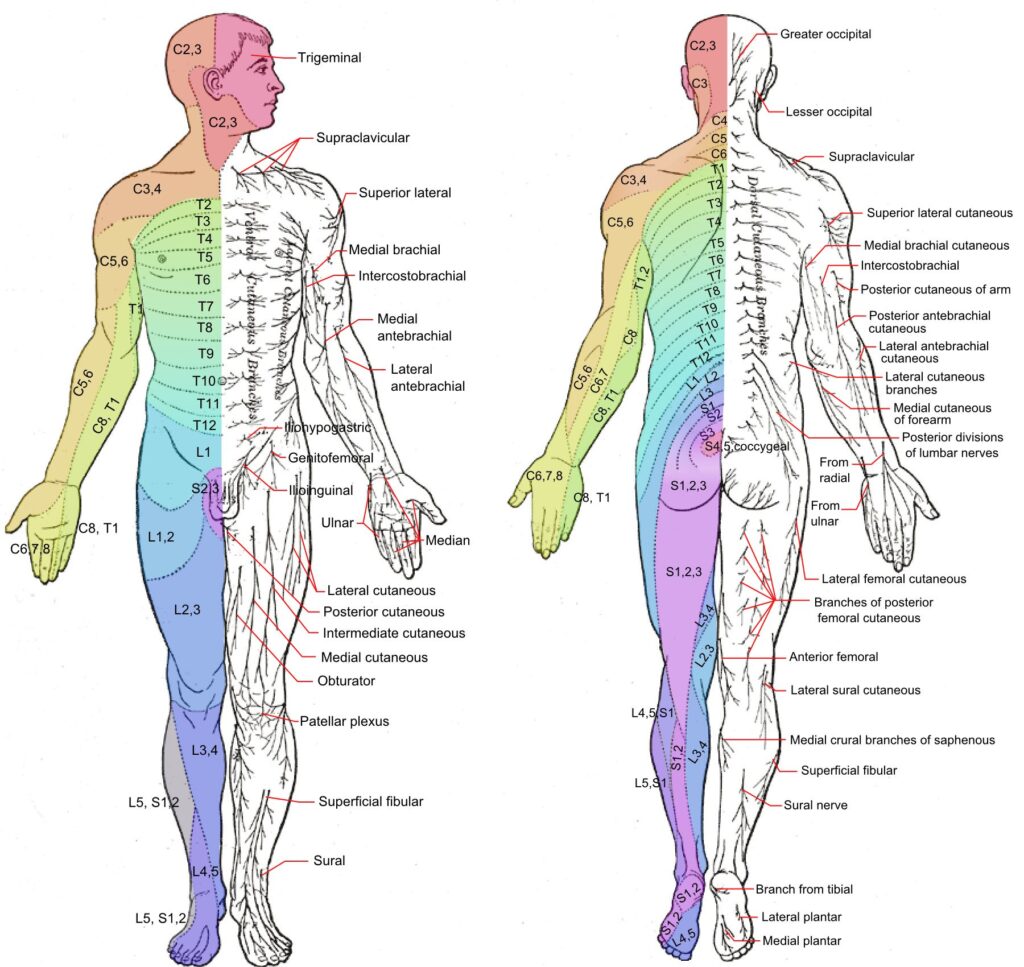
Numbness is diminished or loss of sensation in the skin. Paresthesia is abnormal sensation in the skin, such as tingling and pins and needles. In Chinese medicine, numbness and paresthesia are due to failure of blood to reach and nourish the skin. The skin relies on a steady supply of blood to maintain its elasticity and sensitivity. If blood is inadequate, poorly distributed or blocked by a pathogen, numbness and paresthesia can result.
Etiology
External Pathogens
External pathogens such as wind damp and damp heat can infiltrate the surface and block the distribution of qi and blood though the superficial tissues.
Qi and Blood Deficiency
Factors which weaken qi and blood can lead to numbness and paresthesia. An inadequate diet, or any factors that weaken the Spleen, can lead to reduced supply of qi and blood to the skin. When qi is weak, it may be unable to lead blood up to the most superficial layers of the skin. Weak qi can also lead to a failure of protective wei qi, enabling external pathogens to gain access. Qi and blood deficiency can also be caused by factors such as overwork, prolonged breast feeding or loss of qi and blood from hemorrhage during child birth.
Yin Deficiency
There are two mechanisms whereby yin deficiency can cause numbness and paresthesia; failure of yin to nourish the tissues, and failure of yin to restrain the yang leading to creation of internal wind. Both are associated with a decline in yin from ageing, depletion of yin by fever or chronic disease, or damage to yin by a heating diet, chronic damp heat, drug use or deterioration of qi and blood deficiency. Yin and blood share the role of nourishing, moistening and maintaining the elasticity of skin, hair, joints and sinews. Weak yin can lead to dryness and thinning of the skin, with loss of sensitivity.

Phlegm
Phlegm causes numbness and paresthesia by congealing in the tissues, obstructing the network vessels and impending the circulation of qi and blood.
Blood Stasis
Numbness and paresthesia from blood stasis can be acute or chronic. When acute, it is usually the result of physical trauma or surgery. When chronic, it is the end result of other pathology that slows or impedes blood flow, such as Liver qi constraints, cold, phlegm, damp heat or deficiency of yang qi, blood or yin. Blood stasis that contributes to numbness can also result from prolonged inactivity, and awkward sleeping position, sitting in one position for long periods of time, heavy cigarette smoking and dehydration. In general, blood stasis causes complete loss of sensation and a wooden feeling in tissues.
Nerve Compression
Interference with sensory nerves as they exit the spinal cord, or at some paint along the nerve pathway can cause numbness and paresthesia. This can be caused by a narrowing of the gap between vertebrae due the thinning of the intervertebral disc, growth of osteophytes or muscle spasm. A number of common types of numbness and paresthesia are due to temporary nerve compression. Numbness in the hands and fingers, for example, often wakes people from sleep and can can be caused by an awkward sleep position.

Pathology of the Network Vessels
The network vessels are fine vessels that branch off from the main channels. They are widely distributed through the surface tissues of the body, and enable distribution of qi and blood to the surface beyond the main channel pathways. They reinforce the links between the yin and yang pairs of channels. They also connect the main channels to the surrounding tissues. The network vessels serve to maintain a balance in the ebb and flow of yin and yang through the channels system. They also connect the surface of the body to the internal organ systems, via the intermediary of the main channels.
When numbness is the main complaint, the disease is usually located in the network vessels. Because the network vessels are so fine and diffuse, obstruction within them is insufficiently concentrated to produce pain, the classic feature of qi and blood blockages. When a pathogens is restricted to the network vessels, numbness and paresthesia are the main symptoms. As the disease progresses and moves deeper into the channel system, the blockage becomes more focused and intense, and pain, weakness and wasting start to develop.
Treatment
Acupuncture is the treatment of choice and herbal medicines are recommended to support correcting any systemic imbalances that may be present.
